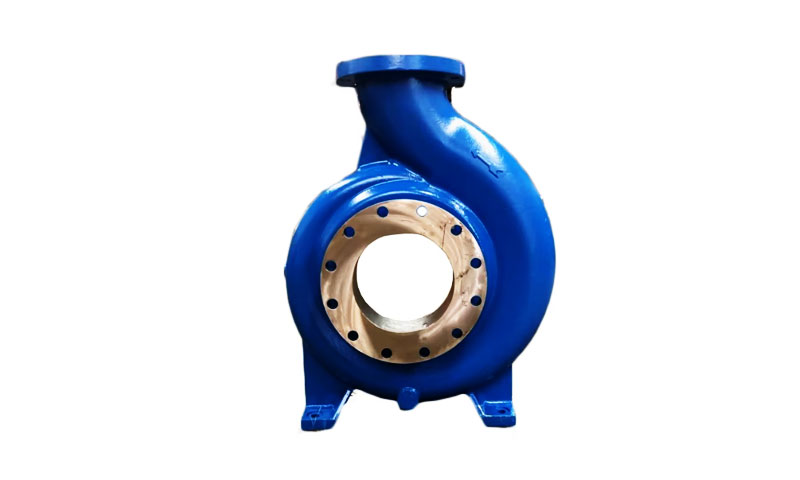1. Увођење
Pump bodies are structural and hydraulic housings that convert driver energy into fluid motion. They commonly contain volutes, impeller seats, bearing bosses, flanges and internal passages.
The manufacturing route chosen for a pump body sets achievable geometry, металургија, cost and lead time.
Investment casting stands out where geometry is complex (internal guide vanes, thin webs, integrated bosses), tolerances are tight, and high-integrity alloys (нехрђајући челичан, Легуре никла, бронзес) су потребни.
2. What Is an Investment Casting Pump Body?
Definition and core functionality
Ан Инвестициони ливење pump body is a pump housing produced by the lost-wax (инвестиција) метода ливења.
A wax (или полимер) pattern of the pump body is created, coated in refractory ceramic to build a shell, the wax removed by heating, and molten metal poured into the ceramic mold.
The fired shell is broken away after solidification to reveal a near-net cast pump body that is subsequently finished and inspected.
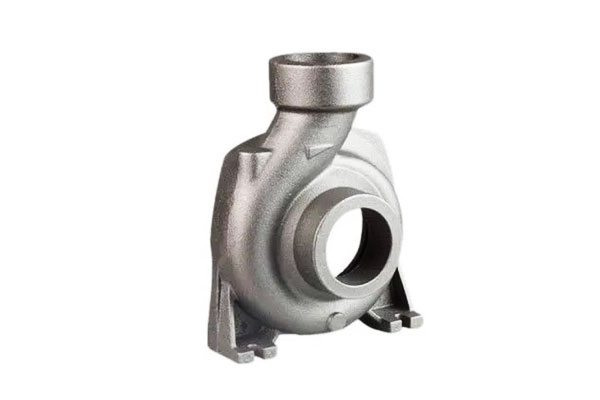
Typical specifications and dimensions
- Part mass: investment cast pump bodies usually range from a few hundred grams to tens of kilograms per piece; many foundries routinely cast pump bodies from ~0.5 kg up to ~50–100 kg depending on plant capability.
- Дебљина зида: typical nominal walls for stainless or nickel alloys: 3-12 мм; minimum thin sections down to 1-2 мм are achievable in selected alloys and process control.
- Димензионална толеранција (улога): general investment cast tolerances commonly fall in ± 0,1-0,5 мм for small features; percent-based tolerance of ±0.25–0.5% linear is a practical rule of thumb.
Critical machined features are usually left with machining allowance (0.2–2.0 mm depending on casting accuracy). - Површинска завршна обрада (улога): typical Ra 1.6-3.2 μм (50-125 мин) for standard ceramic shells; fine shells and careful pouring can produce Ra ≈ 0.8–1.6 μm.
Sealing faces or bearing journals are machined/lapped to much finer Ra (≤ 0.2 μм) as required.
3. Разматрање дизајна
Investment casting enables complex geometry, but good design practice maximizes quality and minimizes cost.
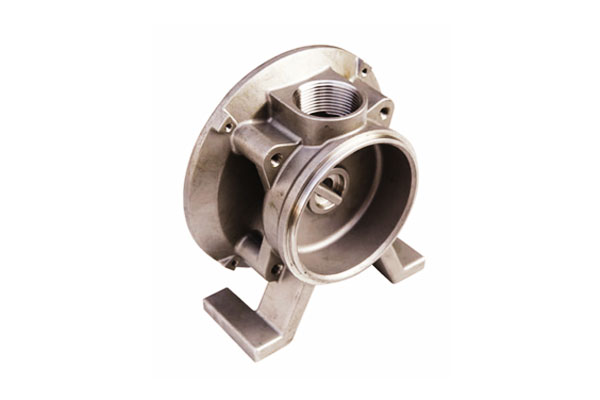
Hydraulic performance requirements
- Flow passages & volutes: smooth fillets and controlled convergence avoid separation and cavitation.
Internal fillet radii should be generous (≥ 1–2× wall thickness) to reduce turbulence. - Impeller seat alignment: concentricity and perpendicularity are critical — plan for machined bores and datum features.
- Clearances: pump clearances at impeller overhangs and seal faces must be maintainable by post-cast machining.
Structural requirements
- Stress & умор: consider cyclical loads; use finite-element analysis to identify local stress risers.
Cast metallurgy (величина зрна, сегрегација) affects fatigue life—design to avoid thin, highly stressed bosses without proper filleting. - Vibration: stiff webs and ribs help raise natural frequencies; investment casting allows ribs to be integrated into the body.
Корозија & носити
- Избор материјала: choose alloy based on fluid chemistry (пХ, хлориди, ерозивна честица, температура).
For seawater, duplex or cupronickel may be required; for acids, Hastelloy or appropriate nickel alloys. - Erosion resistance: smooth internal surfaces and sacrificial coatings (који тврди, топлотни спреј) are options where particulate slurry is present.
Димензионалне толеранције & површинска завршна обрада
- Критичне карактеристике: designate which faces/bores are finish-machined and specify machining allowances (Нпр., 0.5–1.5 mm for sandier shells, 0.2–0.6 mm for precision shells).
- Sealing surfaces: specify Ra and flatness; often lapped/polished to Ra ≤ 0.2 μm and flatness within 0.01-0.05 мм depending on pressure class.
4. Materials for Investment Casting Pump Bodies
Material selection is a critical factor in designing and producing investment-cast pump bodies, as it directly affects mechanical performance, отпорност на корозију, доношење, и сервисни живот.
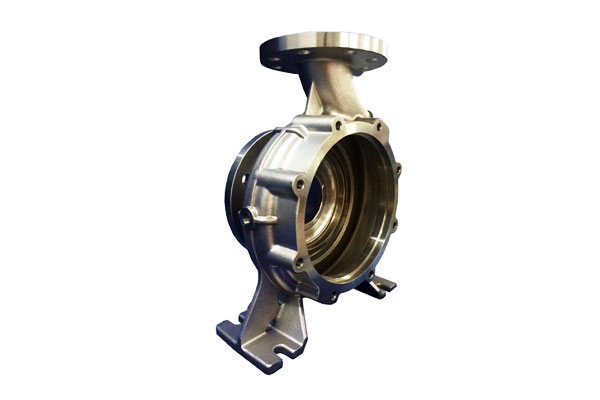
| Категорија материјала | Пример легура | Кључна својства | Типичне апликације | Разматрања ливења |
| Аустенитски нерђајући челик | 304, 316Л | Одлична отпорност на корозију, Умерена снага, добра завариваност; Затезан: 480-620 МПА, Принос: 170-300 МПА, Издужење: 40-60% | General chemical pumps, пречишћавање воде, храна & пијарење | Good molten fluidity, low hot-cracking risk, easy post-machining |
| Дуплек нерђајући челик | 2205, 2507 | Велика снага (Yield 450–550 MPa), superior chloride stress corrosion resistance | Marine and offshore pumps, Агресивно хемијска окружења | Requires controlled temperature; post-casting heat treatment to prevent sigma phase |
Легуре никла |
Уносилац 625, 718; Хастеллои | Изузетна отпорност на корозију, Снага високог температура, отпорност на оксидацију | Хемијска обрада, генерација електричне енергије, уље & гас | High melting points (≈1450–1600 °C); careful mold preheating and controlled pouring needed; difficult machining |
| Бронза and Copper Alloys | Ц93200, Ц95400 | Одлична отпорност на корозију морске воде, Добра отпорност на хабање, antifouling; lower mechanical strength | Морске пумпе, хлађење морске воде, Хидрауличне компоненте | Lower melting points (≈1050–1150 °C) simplify casting; low thermal cracking risk; mechanical strength lower than stainless/nickel |
5. Investment Casting Process for Pump Bodies
Инвестициони ливење, такође познат и као Изгубљени ливење воска, enables the production of pump bodies with complex geometries, танки зидови, и прецизност високе димензије.
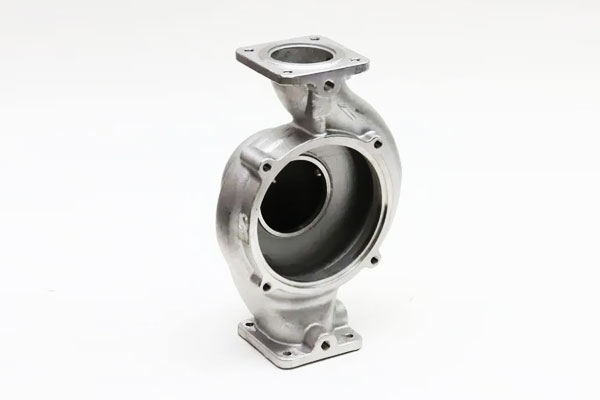
The process consists of several critical steps:
| Корак | Опис | Кључна разматрања |
| 1. Креирање вакског узорка | Molten wax is injected into precision molds to form replicas of the pump body. | Ensure uniform wall thickness; maintain dimensional accuracy ±0.1 mm; use high-quality wax to prevent distortion. |
| 2. Assembly of Wax Tree | Individual wax patterns are attached to a central wax sprue to form a tree for batch casting. | Sprue design affects metal flow; minimize turbulence during pouring. |
| 3. Зграда керамичке шкољке | Repeated dipping in ceramic slurry and stuccoing with fine refractory sand creates a strong, љуска отпорна на топлоту. | Target shell thickness (5-10 мм) depends on pump body size; avoid cracks and porosity in the shell. |
| 4. Dewaxing and Mold Firing | Wax is melted out (autoclave or kiln), остављајући шупљину; the ceramic shell is then fired to remove residues and strengthen the mold. | Temperature ramping must be controlled to prevent shell cracking; residual wax must be fully removed. |
5. Метал Поуринг |
Растопљени метал (нерђајући челик, nickel alloy, или бронза) is poured into the preheated ceramic mold under gravity or vacuum-assisted conditions. | Pouring temperature and rate must ensure complete filling; control turbulence and prevent oxide formation. |
| 6. Очвршћавање и хлађење | Metal solidifies inside the mold; cooling rates affect microstructure, механичка својства, и преостали стрес. | Thick sections may require controlled cooling to prevent porosity; thin walls must avoid hot tearing. |
| 7. Уклањање љуске | Ceramic shell is broken away mechanically, often using vibration, sand blasting, or chemical dissolution. | Avoid damaging intricate pump channels or flanges. |
| 8. Finishing and Cleaning | Residual ceramic, gating system, and surface imperfections are removed via grinding, размазивање, or chemical cleaning. | Maintain dimensional tolerances; prepare surfaces for subsequent machining or coating. |
6. Пост-ливење операција
After the pump body is removed from the ceramic shell, several post-casting operations are performed to ensure the component meets functional, димензионалан, и захтеви за квалитет површине.
These operations are critical for high-performance applications in chemical, маринац, и индустријски сектори.
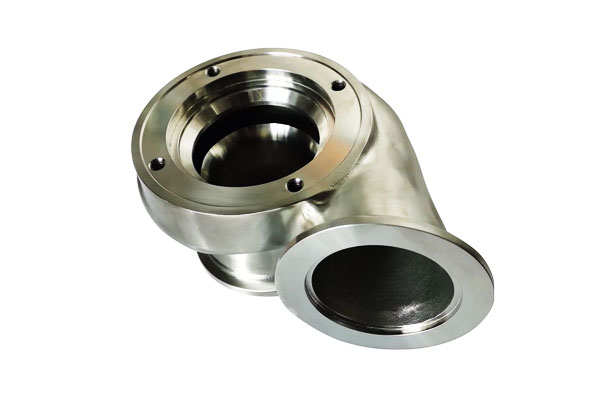
Топлотни третман
Топлотни третман is applied to relieve residual stresses, побољшати дуктилност, and optimize mechanical properties:
- Обнова стреса: Heating to 550–650 °C for stainless steels reduces residual stress from casting and prevents distortion during machining.
- Решење жарења: Applied for stainless steels and nickel alloys to homogenize microstructure and dissolve unwanted precipitates, ensuring corrosion resistance and consistent hardness.
- Aging or Precipitation Hardening (for certain alloys): Enhances strength and wear resistance in high-performance materials.
Обрада
Critical dimensions such as flanges, расипање, mating surfaces, and threaded ports are machined to meet tight tolerances.
Typical machining operations include turning, глодање, бушење, and boring. Machining ensures:
- Dimensional tolerances of ±0.05–0.1 mm for precise assembly.
- Smooth sealing surfaces to prevent leaks in high-pressure applications.
Површинска обрада
Дорада површине Појачава отпорност на корозију, отпорност на хабање, и естетика:
- Полирање: Improves smoothness for sealing faces and internal channels.
- Размазивање: Removes residual ceramic particles and creates a uniform surface for coating or painting.
- Превлаке: Optional chemical or electroplated coatings (Нпр., никл, ПТФЕ) enhance corrosion resistance and reduce friction.
Неразорно тестирање (НДТ)
To detect defects such as porosity, пукотина, или инклузије, NDT is performed:
- Радиографија (Рендген): Identifies internal voids and inclusions.
- Ултразвучно тестирање (Ут): Detects subsurface flaws in thick sections.
- Пробојно тестирање (Пт): Reveals surface cracks and porosity.
Cleaning and Inspection
Коначно, pump bodies are cleaned to remove residual machining oils, Крхотина, or salts. Dimensional and visual inspections verify compliance with specifications before assembly or shipment.
7. Quality Assurance and Testing
Осигурање квалитета (QA) is critical in ensuring that investment casting pump bodies meet design specifications, performance standards, и захтеви за индустрију.
A systematic QA approach combines dimensional checks, Механичко испитивање, and non-destructive evaluation to detect defects and confirm functional integrity.
Димензионална инспекција
Dimensional verification ensures that the pump body conforms to design drawings and tolerances:
- Координиране мерне машине (Цмм): Measure complex geometries, расипање, прирубница, and mounting surfaces with accuracy of ±0.01–0.05 mm.
- Gauge Tools: Thread gauges, plug gauges, and height gauges verify critical features quickly in production.
- Мерење храпавости површине: Confirms finishing requirements for sealing faces and internal channels (Нпр., Ra ≤0.8 μm for hydraulic components).
Mechanical Property Verification
Mechanical testing validates that the material meets required strength, дуктилност, и тврдоћа:
- Затезање: Measures yield strength, крајња затезна чврстоћа, и издужење, ensuring the material can withstand operational loads.
- Тестирање тврдоће: Rockwell or Vickers testing confirms that heat treatment and material processing achieved the desired hardness.
- Испитивање утицаја (ако је потребно): Evaluates toughness for applications exposed to fluctuating loads or shock.
Неразорно тестирање (НДТ)
NDT techniques detect hidden defects without damaging the part:
- Радиографија (X-ray/CT Scanning): Identifies internal porosity, инклузије, and voids, particularly in thick sections.
- Ултразвучно тестирање (Ут): Detects internal cracks, празнине, or delaminations in dense materials like stainless steel and nickel alloys.
- Пробојно тестирање (Пт): Reveals surface cracks, рох, or fine porosity not visible to the naked eye.
- Magnetic Particle Testing (Мт): Applied for ferromagnetic alloys to detect surface and near-surface discontinuities.
Common Casting Defects and Mitigation Strategies
- Порозност: Minimized through proper gating, одзрачивање, and controlled solidification rates.
- Шупљине скупљања: Addressed via riser design and thermal management.
- Хладноће се и мисунс: Avoided by maintaining optimal pouring temperatures and smooth flow in complex geometries.
- Surface Inclusions: Controlled by using high-purity alloys and proper degassing techniques.
8. Advantages of Investment Casting for Pump Bodies
- Сложена геометрија: Унутрашње одломаке, thin walls and integrated bosses with minimal secondary assembly.
- Блиско-нето облик: reduces material removal vs. rough machining from bar or billet — often 30–70% less machining за сложене делове.
- Висока димензионална тачност & површинска завршна обрада: less secondary finishing for many features compared with sand casting.
- Alloy flexibility: cast many stainless and nickel alloys with good metallurgical integrity.
- Small to medium production flexibility: tooling for wax patterns is relatively inexpensive vs. large die tooling, enabling economic runs from prototypes to thousands of parts.
9. Ограничења и изазови
- Cost for very large parts: above certain sizes (често >100 кг) investment casting becomes uneconomical compared with sand casting or fabricating/ welding.
- Временско време: pattern tooling, shell building and firing add lead time—prototype timelines usually measured in weeks.
- Porosity risk in thick sections: thick bosses or large cross-sections require careful gating, chills or segmenting to avoid shrinkage.
- Surface finish and tolerances depend on shell system: achieving ultra-fine finishes or extremely tight as-cast tolerances requires premium ceramic systems and process control.
10. Индустријске апликације
Investment casting pump bodies are used across a broad spectrum of industries due to their complex geometry capabilities, Свестраност материјала, и прецизност високе димензије.
The process allows engineers to design optimized hydraulic passages, танки зидови, and integrated mounting features that improve pump efficiency and longevity.
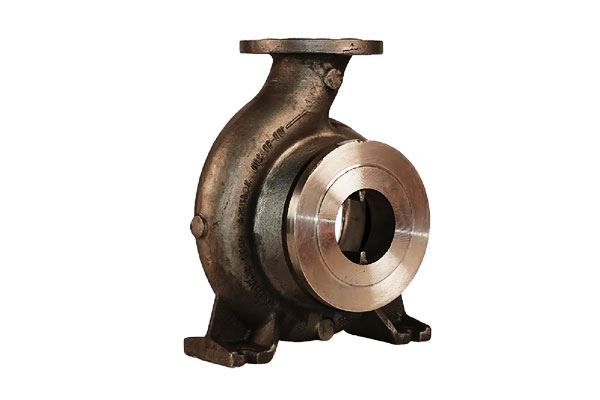
Chemical Processing Pumps
- Окружење: Corrosive fluids such as acids, caustics, и растварачи.
- Materials Used: Нехрђајући челичан (316Л, дуплекс) and nickel alloys (Хастеллои, Уносилац).
- Образложење: Investment casting enables intricate internal channels, minimizing turbulence and ensuring uniform flow, critical for chemical process reliability.
Water and Wastewater Pumps
- Окружење: High-volume pumping, abrasive suspended solids, and variable pH levels.
- Materials Used: Бронза, Дуплек нерђајући челик, and corrosion-resistant cast irons.
- Образложење: Thin-wall, smooth internal passages reduce clogging and energy losses, improving efficiency in municipal and industrial water systems.
Marine and Offshore Pumps
- Окружење: Saltwater exposure, high-pressure operation, and cyclical mechanical stress.
- Materials Used: Легуре бакра (морнаричка месинга, бронза), Дуплек нехрђајући челик.
- Образложење: Resistance to corrosion and biofouling is critical; investment casting allows seamless, complex geometries to reduce maintenance and improve service life.
Уље & Gas and Power Generation Pumps
- Окружење: Висока температура, high-pressure fluids, and hydrocarbon-based media.
- Materials Used: High-nickel alloys (Уносилац, Хастеллои), нерђајући челик, and cobalt-based alloys.
- Образложење: Investment casting supports high-strength materials and precise tolerances necessary for critical applications such as turbine lubrication, chemical injection, and offshore drilling.
Specialty and Custom Pumps
- Окружење: Laboratory, фармацеутски, or food processing applications requiring hygienic and precision performance.
- Materials Used: Нехрђајући челик (304, 316Л), титанијум, или никл легуре.
- Образложење: Глатке површине, чврсте толеранције, and complex geometries achieved by investment casting ensure minimal contamination risk and compliance with regulatory standards.
11. Упоредна анализа
| Значајка / Критеријуми | Инвестиционо ливење | Ливење песка | Machining from Solid |
| Геометријска сложеност | Excellent – thin walls, Унутрашњи канали, intricate features achievable | Moderate – limited by core placement and mold stability | Limited – complex internal geometries often impossible without assembly |
| Димензионална тачност | High – ±0.1–0.25 mm typical | Moderate – ±0.5–1.0 mm | Very High – ±0.05 mm achievable |
| Површинска завршна обрада (По) | Fine – 1.6–3.2 μm typical; can be polished | Rough – 6–12 μm; requires machining for precision | Excellent – 0.8–1.6 μm achievable with finishing |
| Опције материјала | Wide – stainless steels, Легуре никла, бронза, легуре бакра | Wide – iron, челик, бронза, алуминијум | Wide – depends on machinable stock availability |
| Величина серије | Low-to-medium – 1–1000+ parts | Medium-to-high – economical for large, Једноставни делови | Low – material waste increases cost for large parts |
| Временско време | Moderate – wax pattern & shell building required | Short-to-moderate – mold preparation relatively quick | Variable – depends on machining complexity |
Материјални отпад |
Low – near-net shape reduces scrap | Moderate – gating and risers generate some waste | High – subtractive process creates chips and offcuts |
| Трошак по дијелу | Moderate-to-high – tooling and process steps increase cost, economical for complex parts | Low-to-moderate – simpler molds, larger parts cheaper | High – extensive machining on large, complex parts is expensive |
| Снага & Интегритет | Excellent – dense microstructure, minimal porosity if controlled | Moderate – risk of sand-related inclusions and porosity | Excellent – homogeneous, Нема оштећења ливења |
| Post-Processing Required | Often minimal – some machining, завршњак | Usually significant – machining and finishing required | Minimal – final finishing for tight tolerances only |
| Типичне апликације | Pump bodies with thin walls, complex hydraulic channels, отпорност на корозију | Велики, simple pump housings or structural components | Custom or prototype pump bodies requiring extreme precision |
12. Закључак
Investment casting pump body combines design freedom with metallurgical integrity, making them an excellent choice for many fluid-handling applications—especially where complex internal geometry, exotic alloys or tight tolerances are required.
Success depends on early design for casting, informed material selection, careful process control (сипајући, shelling, топлотни третман), and robust QA/NDT programs.
For critical pump systems—marine, chemical or power generation—investment casting can deliver reliable, economical components when specified and executed correctly.
Често постављана питања
What maximum size of pump body can be investment cast?
Typical shop practice ranges up to ~50–100 kg per part, but the practical maximum depends on foundry capability and economics.
Very large pump bodies are more often produced by sand casting or fabricating/welding.
How much machining allowance should I design into an investment casting?
Дозволити 0.2-2.0 мм depending on the criticality and shell precision. Specify tighter allowances only where the foundry guarantees precision shells.
Which material is best for seawater pump bodies?
Duplex stainless steels and selected copper-nickel alloys are common choices due to superior chloride pitting resistance and biofouling performance; final selection depends on temperature, velocity and erosion conditions.
What is the typical turnaround time for an investment-cast pump body?
Small production runs typically take 4-8 недеља from pattern approval to finished parts; single prototypes can be faster with 3D-printed patterns but still require shell firing and melt schedules.
How do I specify acceptance criteria for porosity?
Use industry NDT standards (радиографија, Цт, Ут) and define acceptance levels in percent porosity by volume or via reference images.
Critical pressure-retaining pump bodies often require porosity <0.5% by volume and radiographic acceptance per customer standard.
